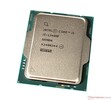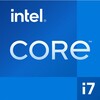Intel Core i5-13400F vs Intel Core i5-12600K vs Intel Core i7-12700F
Intel Core i5-13400F
► remove from comparison
The Intel Core i5-13400F is a mid-range desktop processor of the Raptor Lake series. It includes a hybrid architecture for the CPU cores with combined 10 cores. Six fast Golden Cove / Raptor Cove performance cores (P-cores) with HyperThreading and a clock speed of 3.5 - 5.1 GHz and four Gracemont efficiency cores without HyperThreading and a clock speed of 2.6 - 3.9 GHz. The 13400F can be based on the older Alder Lake chips (at least for early models) or the newer Raptor Lake chips. The F-series of CPUs do not integrate a iGPU.
The performance is clearly higher than the old Core i5-12400F due to the additional four E-cores. These help in multi-threaded workloads and the higher boost core of the p-cores help for single threaded workloads.
The power consumption of the 13400F is rated at 65 Watt for sustained workloads (PL1) and 148 Watt for short bursts (PL2).
Intel Core i5-12600K
► remove from comparison
The Intel Core i5-12600K is a mid-range CPU for desktops based on the Alder Lake architecture. It was first announced in November 2021 and offers 6 performance cores and 4 efficiency cores. The performance cores (P-cores) support HyperThreading, leading to 16 Threads that can be processed at once. The performance cores can clock with up to 4.9 GHz, the efficiency cores can clock with up to 3.6 GHz. All cores can use 20 MB Smart Cache. The integrated memory controller supports up to 128 GB DDR5 with 4800 MT/s (dual channel).
Thread Director (in hardware) can support the operating system to decide which thread to use on the performance or efficiency cores for the best performance.
The integrated graphics adapter is based on the Xe-architecture and called Intel UHD Graphics 770. It clocks between 300 and 1.45 GHz.
For AI tasks, the CPU also integrates GNA 3.0 and DL Boost. Quick Sync in version 8 is the same as in the Rocket Lake CPUs and supports MPEG-2, AVC, VC-1 decode, JPEG, VP8 decode, VP9, HEVC and AV1 decode in hardware.
Performance
The average 12600K in our database is way ahead of the Ryzen 9 3900 and the Core i9-10900K, as far as multi-thread benchmark scores are concerned. This is a very fast CPU that should have no trouble running triple-A games for at least a couple of years.
Power consumption
This Core i5 series chip has a Base power consumption of 125 W, with its maximum Intel-recommended Turbo power consumption sitting at 150 W.
The i5-12600K is built with Intel's fourth generation 10 nm process marketed as Intel 7 for lower-than-average, as of mid 2023, energy efficiency.
Intel Core i7-12700F
► remove from comparison
The Intel Core i7-12700F is a high end CPU for desktops based on the Alder Lake architecture. It was first announced in November 2021 and offers 8 performance cores and 4 efficiency cores. The performance cores (P-cores) support HyperThreading, leading to 20 threads that can be processed at once. The performance cores can clock with up to 4.9 GHz (Turbo Boost Max 3.0, 2.1 base), the efficiency cores can clock with up to 3.6 GHz (1.6 GHz base). All cores can use 25 MB Smart Cache. The integrated memory controller supports up to 128 GB DDR5 with 4800 MT/s (dual channel).
The Thread Director (in hardware) can support the operating system to decide which thread to use on the performance or efficiency cores for the best performance.
For AI tasks, the CPU also integrates GNA 3.0 and DL Boost. Quick Sync in version 8 is the same as in the Rocket Lake CPUs and supports MPEG-2, AVC, VC-1 decode, JPEG, VP8 decode, VP9, HEVC and AV1 decode in hardware.
The F-series desktop models don't offer an integrated graphics card.
The CPU is rated at 65 W base power and 180 Watt maximum Turbo power. It is manufactured in 10nm, called Intel 7, process at Intel.
| Model | Intel Core i5-13400F | Intel Core i5-12600K | Intel Core i7-12700F | ||||||||||||||||||||||||||||||||||||||||||||||||||||||||||||
| Codename | Raptor Lake-S | Alder Lake | Alder Lake | ||||||||||||||||||||||||||||||||||||||||||||||||||||||||||||
| Series | Intel Raptor Lake-S | Intel Alder Lake-S | Intel Alder Lake-S | ||||||||||||||||||||||||||||||||||||||||||||||||||||||||||||
| Series: Alder Lake-S Alder Lake |
|
|
| ||||||||||||||||||||||||||||||||||||||||||||||||||||||||||||
| Clock | 2500 - 4600 MHz | 2800 - 4900 MHz | 3300 - 4900 MHz | ||||||||||||||||||||||||||||||||||||||||||||||||||||||||||||
| L1 Cache | 0.1 MB | 1 MB | |||||||||||||||||||||||||||||||||||||||||||||||||||||||||||||
| L2 Cache | 9.5 MB | 9.5 MB | 12 MB | ||||||||||||||||||||||||||||||||||||||||||||||||||||||||||||
| L3 Cache | 20 MB | 20 MB | 25 MB | ||||||||||||||||||||||||||||||||||||||||||||||||||||||||||||
| Cores / Threads | 10 / 16 | 10 / 16 | 12 / 20 | ||||||||||||||||||||||||||||||||||||||||||||||||||||||||||||
| TDP | 65 Watt | 125 Watt | 65 Watt | ||||||||||||||||||||||||||||||||||||||||||||||||||||||||||||
| Technology | 10 nm | 10 nm | 10 nm | ||||||||||||||||||||||||||||||||||||||||||||||||||||||||||||
| Die Size | 257 mm2 | 215 mm2 | |||||||||||||||||||||||||||||||||||||||||||||||||||||||||||||
| max. Temp. | 100 °C | 100 °C | 100 °C | ||||||||||||||||||||||||||||||||||||||||||||||||||||||||||||
| Socket | LGA 1700 | LGA1700 | LGA 1700 | ||||||||||||||||||||||||||||||||||||||||||||||||||||||||||||
| Features | Intel SSE4.1, Intel SSE4.2, Intel AVX2 | DDR4-3200/DDR5-4800 RAM, PCIe 5, Thr. Dir., DL Boost, GNA, vPro Enterp., MMX, SSE, SSE2, SSE3, SSSE3, SSE4.1, SSE4.2, AVX, AVX2, BMI2, ABM, FMA, ADX, SMEP, SMAP, EIST, TM1, TM2, HT, Turbo, SST, AES-NI, RDRAND, RDSEED, SHA | |||||||||||||||||||||||||||||||||||||||||||||||||||||||||||||
| Architecture | x86 | x86 | x86 | ||||||||||||||||||||||||||||||||||||||||||||||||||||||||||||
| $196 U.S. | $289 U.S. | $386 U.S. | |||||||||||||||||||||||||||||||||||||||||||||||||||||||||||||
| Announced | |||||||||||||||||||||||||||||||||||||||||||||||||||||||||||||||
| Manufacturer | ark.intel.com | ark.intel.com | |||||||||||||||||||||||||||||||||||||||||||||||||||||||||||||
| iGPU | Intel UHD Graphics 770 (300 - 1450 MHz) |
Benchmarks
Average Benchmarks Intel Core i5-13400F → 100% n=46
Average Benchmarks Intel Core i5-12600K → 108% n=46
Average Benchmarks Intel Core i7-12700F → 105% n=46
* Smaller numbers mean a higher performance
1 This benchmark is not used for the average calculation












